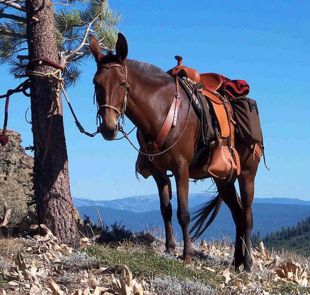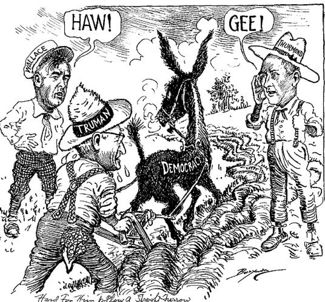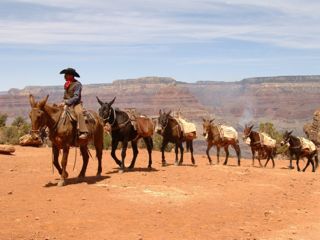Mule
 From Conservapedia
From Conservapedia 
Contents
- 1 Comparisons with horses
- 2 History
- 2.1 United States
- 2.1.1 Cotton farms
- 2.1.2 Transport
- 2.1 United States
- 3 Other uses of the word
- 4 Bibliography
- 5 See also
- 6 External links
- 6.1 notes
Comparisons with horses[edit]
The mule has characteristics of both parents. It has the long ears, tufted tail, and slender legs and hoofs of the donkey, but in coat, shape height and weight is more like the larger horse. Like the donkey, it brays when the horse neighs and has an obstinate, cautious disposition. The tail is always different; horses have a short tailbone with long hair, while mules have a long tailbone with a tassel at the end.
Mules on average are 15-17 hands tall and weigh 1,100 to 1,400 pounds.
While the mule pulls more slowly than the horse, it is more sure-footed and works better under difficult conditions. It is peculiar in many ways and difficult to handle. The owner usually waits until the mule is fully mature (about 5 years old) before assigning heavy work duties.
The mule combines the patience, sure-footedness and endurance of the donkey with the vigor and strength of the horse. It has a thicker, less sensitive hide than the horse, and can wear a harness longer. It is smaller and eats less, and will eat rougher food than a horse. In the late 19th and early 20th century, mules cost 10% to 15% more than horses.
The mule has more ability to endure heat and human abuse, and to live on poor fodder while carrying heavy loads. It is better at pulling plows and wagons. Mules are less prone to disease and live longer with an average work life of about 18 years compared to 12-15 for horses. Mules work harder than either donkeys or horses. Horses are faster and can pull a heavier load for short distances. On city streets horses can better handle the cobblestones and are easier to start and stop. However, on cotton and tobacco farms, the mules were more sure footed and less likely to step on plants.
Both male and female mules are almost always sterile. They are produced by specialty breeders. Horses have colts which can be sold.
History[edit]
Horses get far more attention because of their speed, beauty and military roles. The mule has the story of poverty and tedious hard work. In the history of farming, however, the mule is the more important animal, especially in American history.
Since prehistoric times mules have been raised by people the world over. They are especially popular in Asia.
United States[edit]
The "American Standard Donkey" is descended from two large Spanish jacks that were given to George Washington by the King of Spain. These donkeys are used to produce most mules. Also used is the smaller "Standard Donkey" (formerly called the burro').

Mules were rejected by northern farmers, who used a combination of horses and oxen. They were popular in the South.
Historically, they were the most important farm animal in the South. Since 1950, cotton picking machines and tractors have replaced virtually all working mules, but they are still raised by hobbyists.
Southern farmers made the mule their preferred draft animal in the South during the 1860s-1920s, primarily because it fit better with the region's geography.[2] Mules better withstood the heat of summer, and their smaller size and hooves were well suited for such crops as cotton, tobacco, and sugar. The character of soils and climate in the lower South hindered the creation of pastures, so mule breeding tended to concentrate in the border states of Missouri, Kentucky, and Tennessee. Transportation costs combined with topography to influence the prices of mules and horses, which in turn affected patterns of mule use. The economic and production advantages associated with mules made their use a progressive step for Southern agriculture that endured until the mechanization brought by tractors.
By 1808 the U.S. had 855,000 mules, worth $66 million. By 1897 the numbers had expanded to 2.2 million, worth $103 million. Then came the cotton boom, especially in Texas, so that in 1910 there were 4.1 million mules, worth $120 each. One fourth were in Texas, and the Ft. Worth stockyards became the world center for buying and selling mules.
Cotton farms[edit]
The typical cotton farm, 1865-1950, used mule power. One farmer with two mules could plow 16 acres a day. (With a tractor he could plow 45 acres a day, but tractors were too expensive for poor farmers who only had 40 acres.)[3]

Transport[edit]
Stage coach lines preferred mules to horses (though horses look better and are featured in movies). The stage coaches were pulled by large mules that could travel six to ten miles per hour over flat, dry land.
The U.S. Army used mules to pull supply wagons starting with the Mexican War in 1846-48, down to 1920. Horses were used for cavalry roles. In the Civil War, the U.S. Army used about a million mules; the Confederate army used half as many. They pulled supply trains and artillery pieces. In military jargon, a "shavetails" are newly arrived animals whose tails have been shaved and manes roached to distinguish them as new and untrained. "Bell Sharps" are mules who had been worked long enough so that they knew to follow the bell on the lead mare in a packtrain.
The typical wagon weighed 2000 pounds and carried 3000 pounds of cargo (including feed for the mules), and was pulled by six mules.[4] In mountain country the wagons were useless, and so a set of pack mules was used. A train of 50 or more mules, each carrying 250 pounds, moved in single file and could cover 60 miles a day.
Army mules were essential in World War II in Italy, where rough mountain conditions made trucks useless. The last Army mules were deactivated in 1956.
Other uses of the word[edit]
In the manufacture of cotton textiles, the "mule" or "spinning mule" is an important piece of machinery used in spinning the raw cotton into thread.
The "mule deer" (Odocoileus hemionus) in western North America is a deer with long ears like a mule's.
In sheep farming a "mule" is a kind of sheep.
Bibliography[edit]
- Arnold, Watson C. "The Mule: The Worker that 'Can't Get No Respect,'" Southwestern Historical Quarterly (July 2008) 112:35-52
- Ellenberg, George B. "African Americans, Mules, and the Southern Mindscape, 1850-1950," Agricultural History, Vol. 72, No. 2, (Spring, 1998), pp. 381–398 in JSTOR
- Ellenberg, George B. Mule South to Tractor South: Mules, Machines, Agriculture, and Culture in the South, 1850-1950 (2008)
- Essin, Emmett M. Shavetails and Bell Sharps: The History of the U.S. Army Mule (2000) excerpt and text search
- Garrett, Jr., Martin A. "The Mule in Southern Agriculture: A Requiem," Journal of Economic History, Vol. 50, No. 4 (Dec., 1990), pp. 925–930 in JSTOR
- Hauer, John. The Natural Superiority of Mules (2006) excerpt and text search, good thorough coverage
- Lamb, Robert B. The Mule in Southern Agriculture (1963)
- Sawers, Larry. "The Mule, the South, and Economic Progress." Social Science History 2004 28(4): 667-690. Issn: 0145-5532 Fulltext: in Project Muse and Ebsco
See also[edit]
- Agricultural history of the U.S
External links[edit]
- [ "Longears and Sourdough"]
notes[edit]
- ↑ A "hinney" is a crossbreed between a male horse and a female donkey. It is rare.
- ↑ Sawers (2004)
- ↑ In the 21st century one farmer with a modern tractor can plow 200 acres a day.
- ↑ Horses needed more fodder which took up more cargo space, and they were not as surefooted in the rough lands.
Categories: [Odd-Toed Ungulates] [Livestock]
↧ Download as ZWI file | Last modified: 02/25/2023 12:29:53 | 158 views
☰ Source: https://www.conservapedia.com/Mule | License: CC BY-SA 3.0
 ZWI signed:
ZWI signed: KSF
KSF